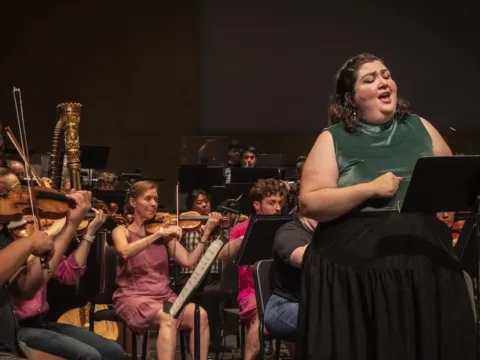Stravinsky’s Rite of Spring: has any piece of music written since 1913 been so genuine yet so alien, so hyper yet so heavy, so focused yet so wild, so colorful yet so bleak? Attractive in all its dualities, this work has had something of a track record at the Ojai Festival, realized in 2012 by the Hamelin-Andsnes piano duo and in 2013 by The Bad Plus. It should also be noted that Igor Stravinsky–himself a postwar LA émigré–was the music director for the festival from 1955-56. At the 2017 Ojai Music Festival, Steven Schick and ICE took up Cliff Colnot’s Sacré, an arrangement for small ensemble.
Listening to Colnot’s arrangement is like looking at the piece in a small-scale model, or through a delicate crystal: so much intricate detail is clarified, but the epic scope is lost. The Saturday June 10th performance at Libbey Bowl had no fat trombone slides or lush string sections; however, the sinuous and animated solo wind lines were as much a joy to watch as they were to hear. The opening fairground action in “The Augurs of Spring” was wonderfully busy, but too heavy–the overarching sense of line was lost, but understandably so. As the house band for the 2017 festival, ICE had an enormous body of work to get under their belts. Transforming the blocky structures of Stravinsky’s music into big phrases can be an enormous challenge that may have required more time than they had available. And even so, a few other highlights shone through: the chords at the beginning of Part II became Messiaen-esque clouds of sound on the piano, while the turbulent percussion breakdown two-thirds through was executed like a well-oiled machine.

The second half of the evening was comprised of a multimedia work that captured the essence–both visually and musically–of Vijay Iyer’s own rite of spring: the Indian tradition of Holi, which marks the carnal union of the goddess Radha with Lord Krishna. A breathtaking film, directed, edited, and designed by Prashant Bhargava (who recently passed), was created along the emotional arc of the original Stravinsky composition. Iyer made a musical complement that played to one of his talents: the sculpting of energy. The resulting work, Radhe Radhe: Rites of Holi, is named after the greeting that is used by those partaking in the Holi frenzy, and in a gracious address to the audience, Iyer dedicated it to his late friend Prashant’s memory.
Bhargava’s film seems to present the entire day with an insatiable appetite for life of all kinds: animals are displayed in all their quirks, people of all ages are seen singing, dancing, stampeding, while technicolored powder flies at them from all angles. By the time of “Intoxication,” we were fully under his spell. And, as the day progressed, we began to see the primal side of the holiday. A certain level of violence that pervades the work became clearer in scenes where beaters come hailing down on the shielded head of kneeling men or women, and villagers rapidly circle a roaring fire. These communal scenes of Holi are juxtaposed with the more private: the goddess Radha, painted in light blue and portrayed in close-ups, observes the masses below, slowly succumbing to the pull of Lord Krishna, whose keen, disembodied hands appear from time to time.

Iyer’s use of open harmonies at the beginning of the work is reminiscent of something like Stravinsky’s Petrushka, but he deftly includes a bassoon solo that both literally and figuratively screames The Rite of Spring. Hats off to ICE bassoonist Rebekah Heller. A splatter of piccolo at the end also pays tribute to the rising flute line signaling the sacrifice at the end of the Stravinsky-Nijinsky ballet.
Saturday night’s concert was another brilliant piece of programming by Iyer and artistic director Tom Morris that came just at the right time: it’s now more than ever that we should continue to recognize the value of how non-Eurocentric voices can contribute to the canon of classical music, really examining the role that America can play in shaping the future of this canon. At the same time, virtual reality and fully immersive installations are proving themselves as new frontiers at the intersection of art and technology. In presenting a tradition from a post-colonial nation that is gaining traction on the global economic stage, and doing so through a multimedia work that thoroughly envelops us in the vibrancy of its spirits and people, Radhe Radhe gripped from start to finish.
























